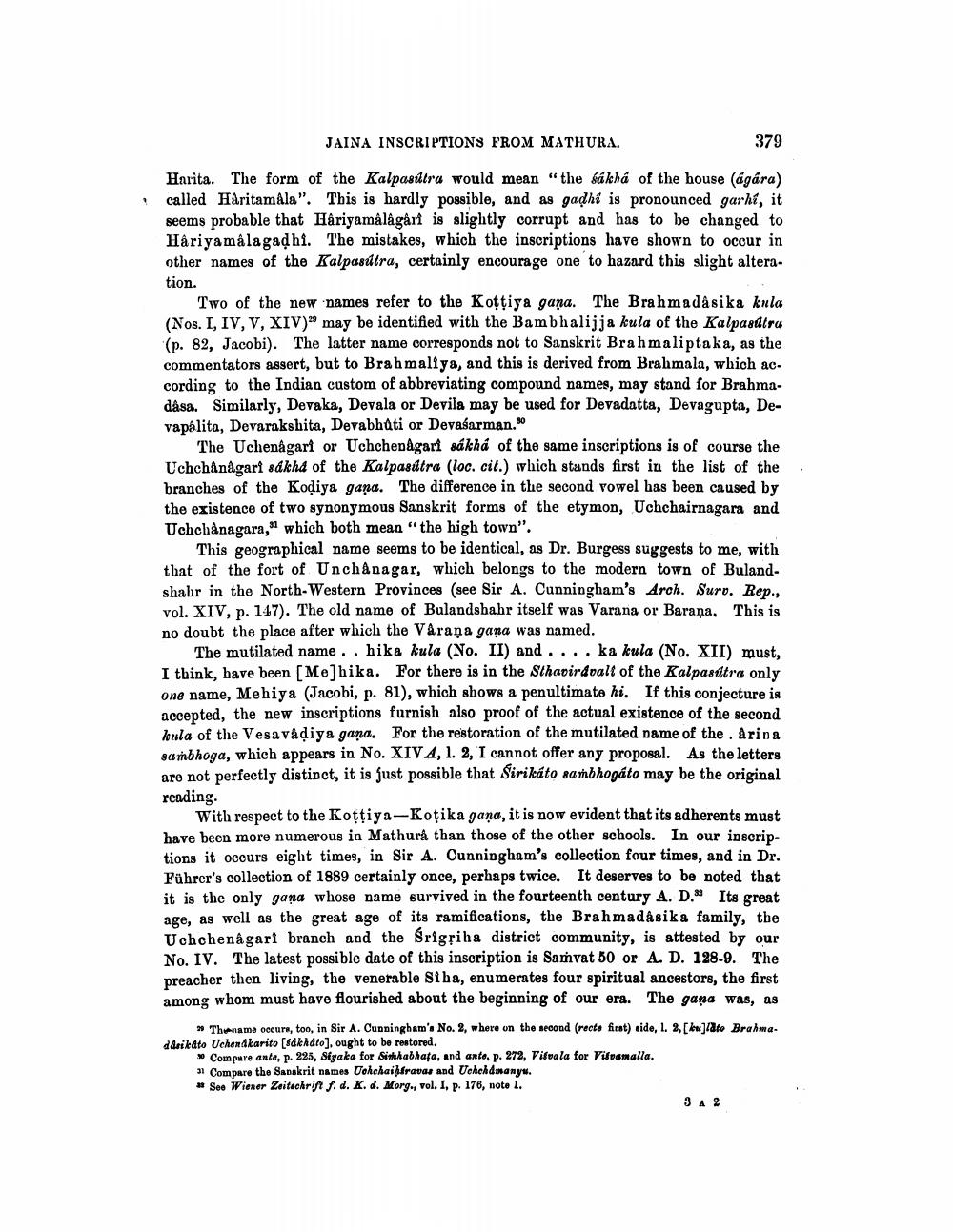________________
JAINA INSCRIPTIONS FROM MATHURA.
379
Harita. The form of the Kalpasútra would mean "the sákhá of the house (ágára) called Haritamala". This is hardly possible, and as gadhi is pronounced garhi, it seems probable that Hariyamålågåri is slightly corrupt and has to be changed to Hâriyamalagadhi. The mistakes, which the inscriptions have shown to occur in other names of the Kalpasútra, certainly encourage one to hazard this slight alteration.
Two of the new names refer to the Kottiya gana. The Brahmadásika kula (Nos. I, IV, V, XIV)? may be identified with the Bambhalijja kula of the Kalpasutra (p. 82, Jacobi). The latter name corresponds not to Sanskrit Brahmaliptaka, as the commentators assert, but to Brahmaliya, and this is derived from Brahmala, which according to the Indian custom of abbreviating compound names, may stand for Brahmadåsa. Similarly, Devaka, Devala or Devila may be used for Devadatta, Devagupta, Devapalita, Devarakshita, Devabhati or Devasarman."
The Uchenågart or Uchchepàgari sákhá of the same inscriptions is of course the Uchchånågart sdkha of the Kalpasitra (loc. cit.) which stands first in the list of the branches of the Kodiya gana. The difference in the second vowel has been caused by the existence of two synonymous Sanskrit forms of the etymon, Uchchairnagara and Uchchanagara," which both mean "the high town".
This geographical name seems to be identical, as Dr. Burgess suggests to me, with that of the fort of Unchanagar, which belongs to the modern town of Buland. shahr in the North-Western Provinces (see Sir A. Cunningham's Arch. Surv. Rep., vol. XIV, p. 147). The old name of Bulandshahr itself was Varana or Barana, This is no doubt the place after which the Varaņa gana was named.
The mutilated name .. hika kula (No. II) and .... ka kula (No. XII) must, I think, have been [Me]hika. For there is in the Sthapirdvalt of the Kalpasútra only one name, Mehiya (Jacobi, p. 81), which shows a penultimate hi. If this conjecture is accepted, the new inscriptions furnish also proof of the actual existence of the second kula of the Vesavadiya gana. For the restoration of the mutilated name of the . Arina sambhoga, which appears in No. XIV A, 1.2, I cannot offer any proposal. As the letters are not perfectly distinct, it is just possible that Sirikáto sambhogáto may be the original reading
With respect to the Kottiya-Koţika gana, it is now evident that its adherents must have been more numerous in Mathura than those of the other schools. In our inscriptions it occurs eight times, in Sir A. Cunningham's collection four times, and in Dr. Führer's collection of 1889 certainly once, perhaps twice. It deserves to be noted that it is the only gana whose name survived in the fourteenth century A. D." Its great age, as well as the great age of its ramifications, the Brahmadásika family. the Uchchenagari branch and the Srigriha district community, is attested by our No. IV. The latest possible date of this inscription is Samvat 50 or A. D. 128-9. The preacher then living, the venerable Siba, enumerates four spiritual ancestors, the first among whom must have flourished about the beginning of our era. The gana was, as
» Thename occurs, too, in Sir A. Cunningham's No. 2, where on the second (recta firat) side, 1. 2. [kw]lato Brahma. ddsikdto Uchendkarito [dk hdto), ought to be restored.
Compare ante, p. 225, Siyaka for Sinhabhara, and anto, p. 272, Vilvala for Vilamalla. 31 Compare the Sanskrit names Tohchairavas and Uchchdmanyu. * See Wiener Zeitschrin f. d. K. d. Morg., vol. I, p. 176, note 1.
3 A 2




